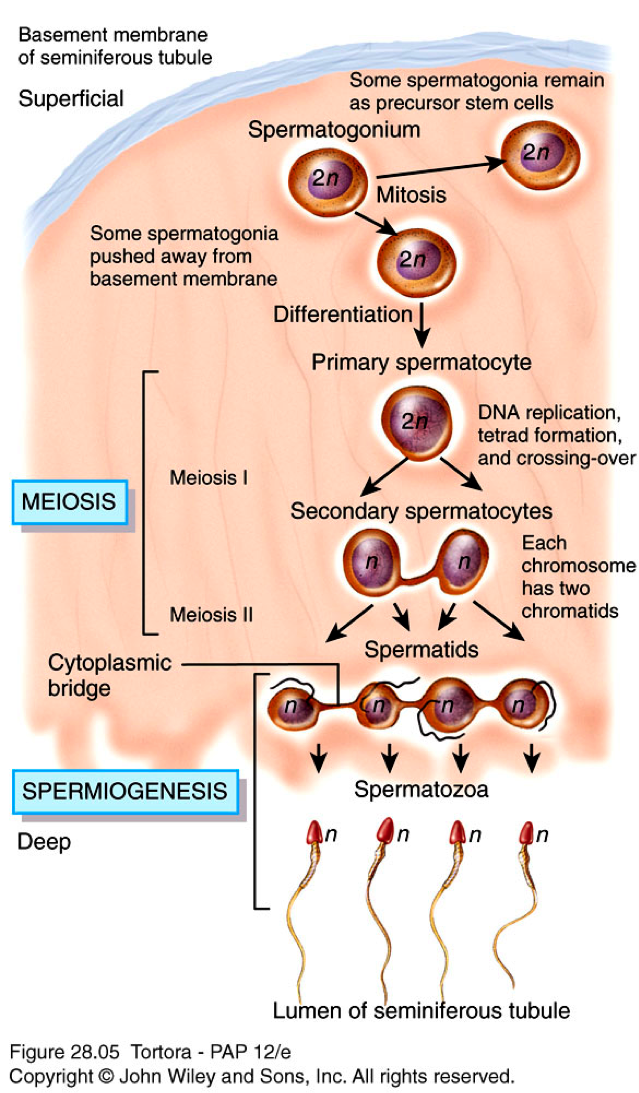Author: Durga Deepthi Kolasani
Spermatogenesis:
The process of formation of sperms is called spermatogenesis.
- In humans, spermatogenesis takes 65–75 days.
- It begins with the spermatogonia, which contain the diploid (2n) number of chromosomes.
- Spermatogonia are types of stem cells; when they undergo mitosis, some spermatogonia remain near the basement membrane of the seminiferous tubule in an undifferentiated state to serve as a reservoir of cells for future cell division and subsequent sperm production.
- The rest of the spermatogonia lose contact with the basement membrane, squeeze through the tight junctions of the blood–testis barrier, undergo developmental changes, and differentiate into primary spermatocytes (SPER-ma-to¯-sı¯tz).
- Primary spermatocytes, like spermatogonia, are diploid (2n); that is, they have 46 chromosomes.
- Shortly after it forms, each primary spermatocyte replicates its DNA and then meiosis begins.
- In meiosis I, homologous pairs of chromosomes line up at the metaphase plate, and
crossing-over occurs. - Then, the meiotic spindle pulls one (duplicated) chromosome of each pair to an opposite pole of the dividing cell.
- The two cells formed by meiosis I are called secondary spermatocytes.
- Each secondary spermatocyte has 23 chromosomes, the haploid number (n). Each chromosome within a secondary spermatocyte, however, is made up of two chromatids (two copies of the DNA) still attached by a centromere.
- No replication of DNA occurs in the secondary spermatocytes.
- In meiosis II, the chromosomes line up in single file along the metaphase plate, and the two chromatids of each chromosome separate.
- The four haploid cells resulting from meiosis II are called spermatids (SPER-ma-tids).
- A single primary spermatocyte, therefore produces four spermatids via two rounds of cell division (meiosis I and meiosis II).
- A unique process occurs during spermatogenesis.
- As spermatogenic cells proliferate, they fail to complete cytoplasmic separation (cytokinesis).
- The cells remain in contact via cytoplasmic bridges through their entire development.
- This pattern of development most likely accounts for the synchronized production of sperm in any given area of the seminiferous tubule.
- It may also have survival value in that half of the sperm contain an X chromosome and half contain a Y chromosome.
- The larger X chromosome may carry genes needed for spermatogenesis that are lacking on the smaller Y chromosome.
- The final stage of spermatogenesis, spermiogenesis (sper- me¯-o¯-JEN-e-sis), is the development of haploid spermatids into sperm. No cell division occurs in spermiogenesis; each spermatid becomes a single sperm cell.
- During this process, spherical spermatids transform into elongated, slender sperm.
- An acrosome forms atop the nucleus, which condenses and elongates, a flagellum develops, and mitochondria multiply.
- Sertoli cells dispose of the excess cytoplasm that sloughs off.
- Finally, sperm are released from their connections to Sertoli cells, an event known as spermiation (sper-me¯-A¯ -shun).
- Sperm then enter the lumen of the seminiferous tubule.
- Fluid secreted by Sertoli cells pushes sperm along their way, toward the ducts of the testes. At this point, sperm are not yet able to swim.
Source: Spermatogenesis TORTORA (Pg. no: 927-931)


Supabb sir…..
LikeLiked by 1 person